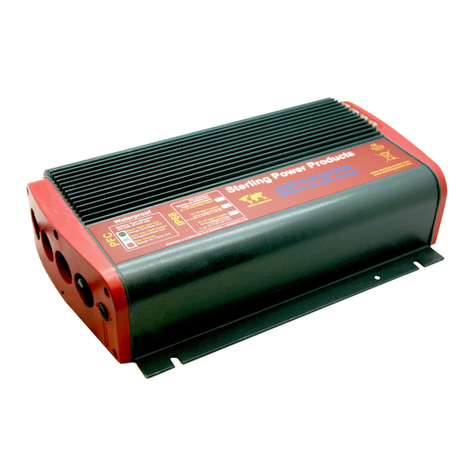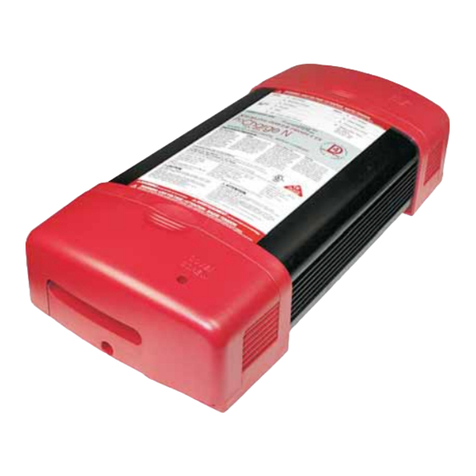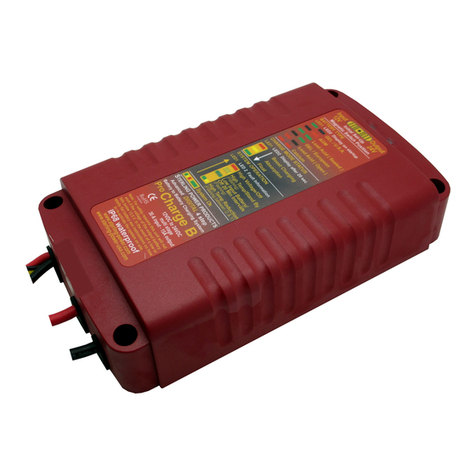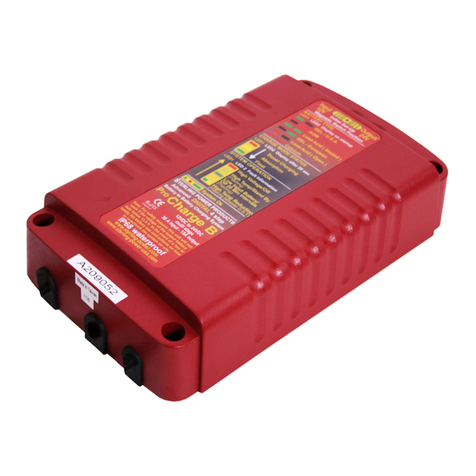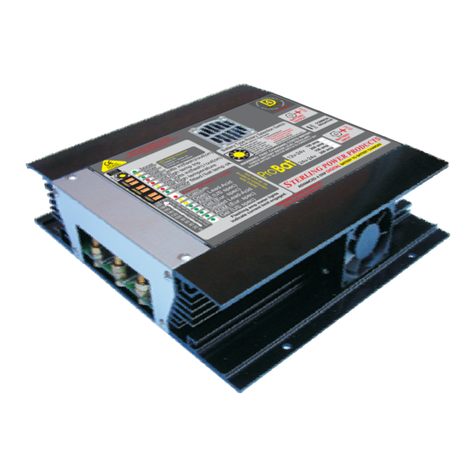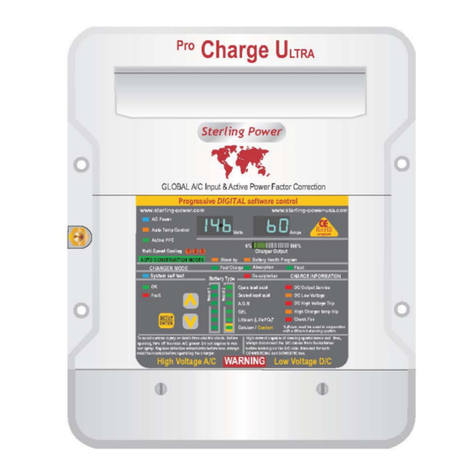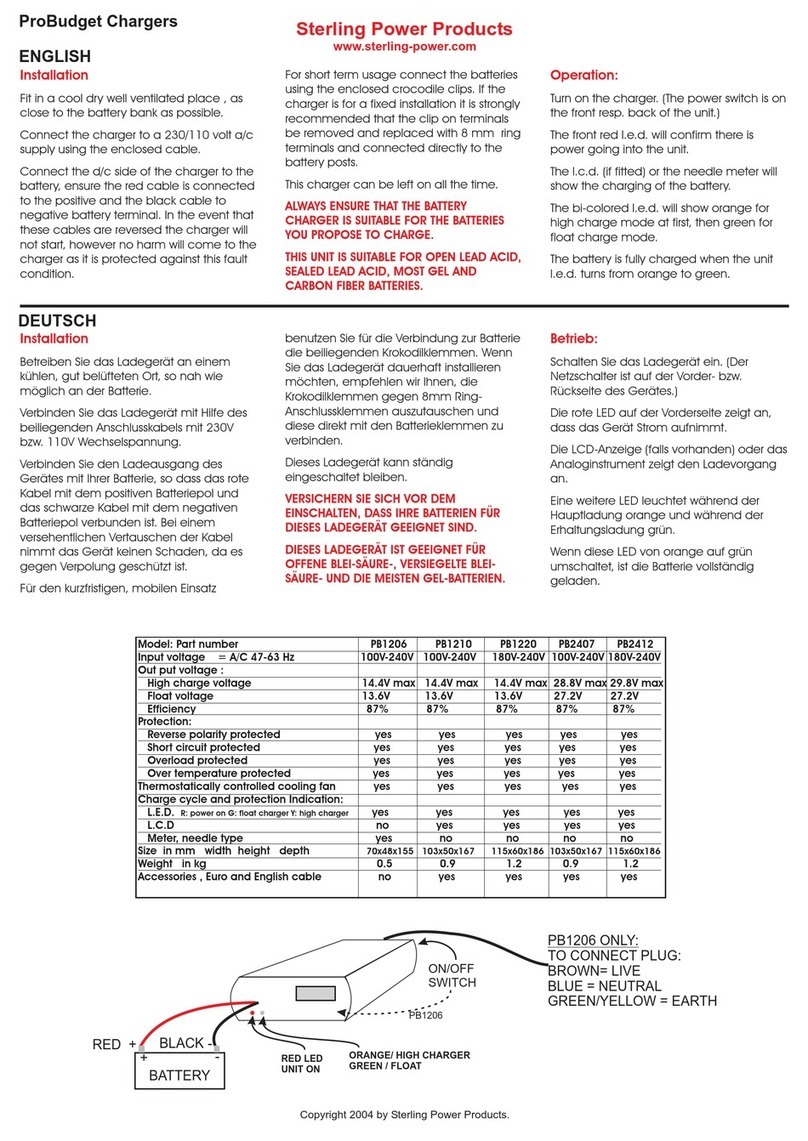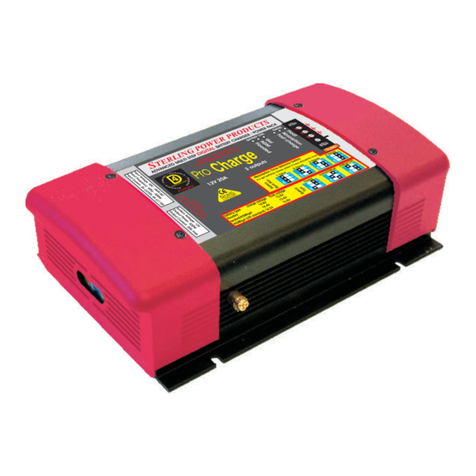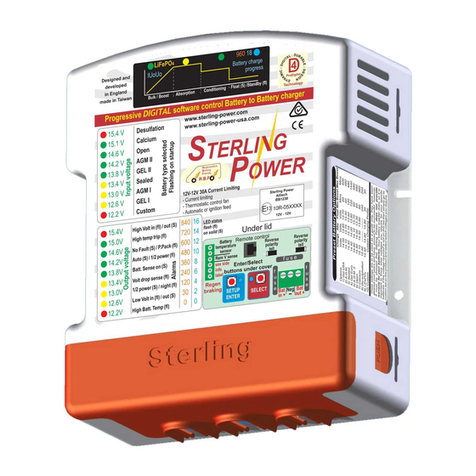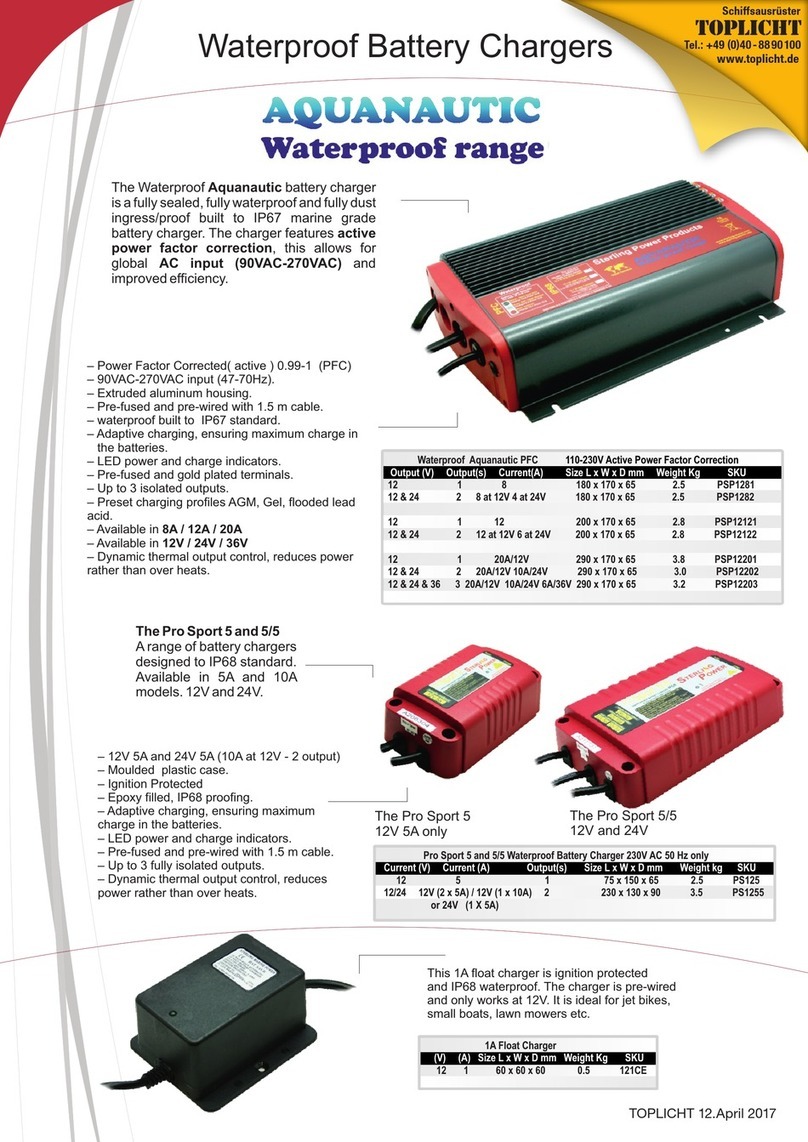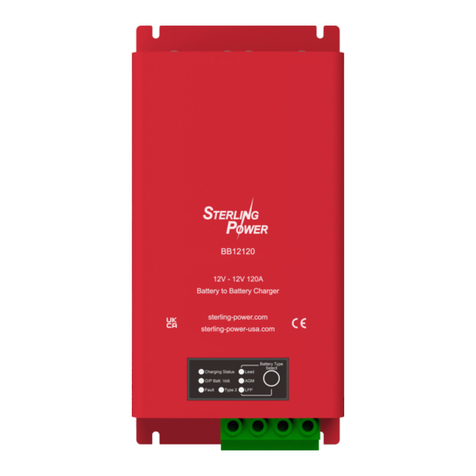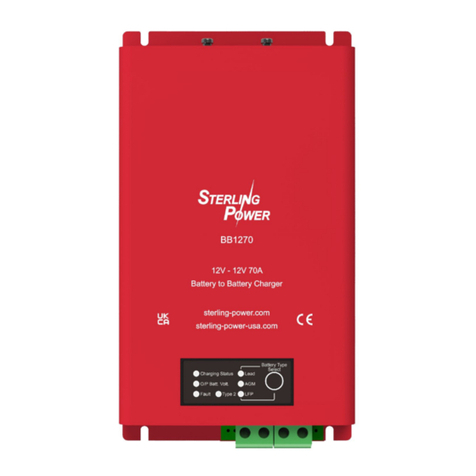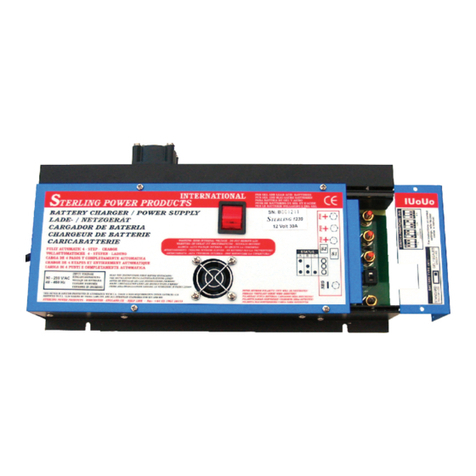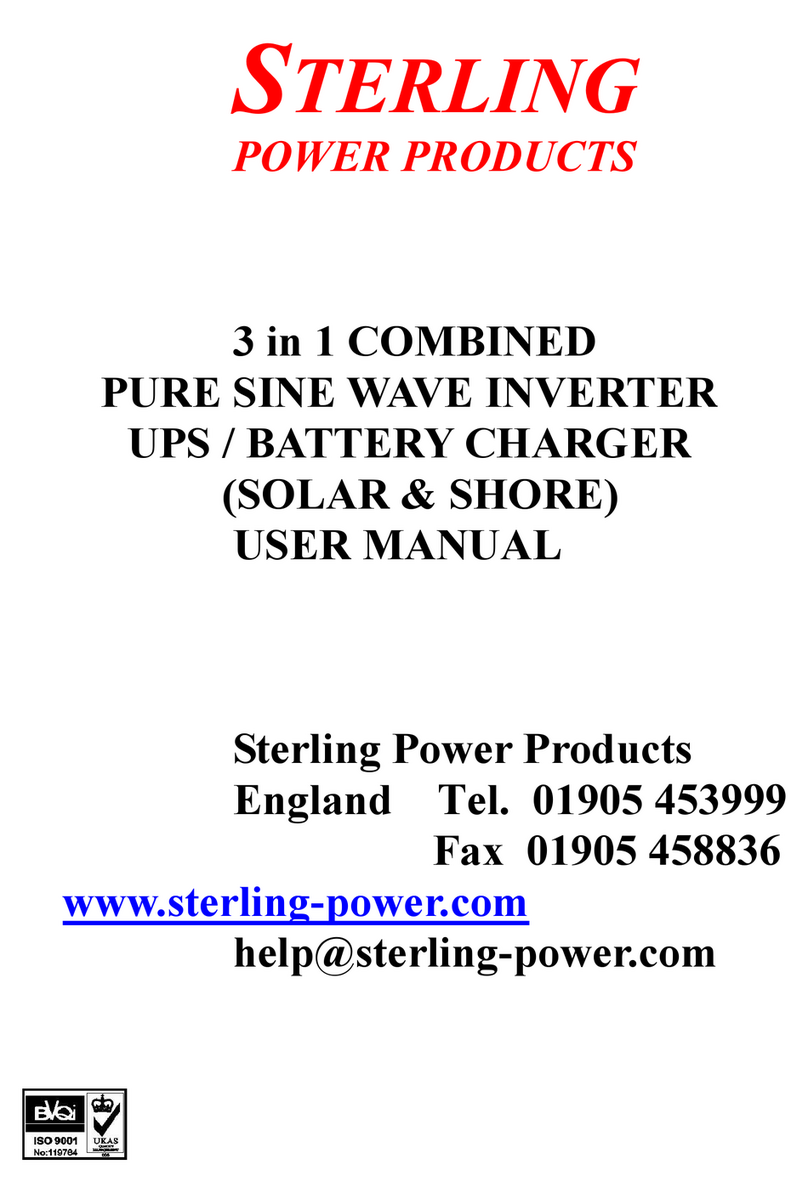
TROUBLESHOOTING
TROUBLESHOOTING 13
STERLING
POWER
Firstly, ensure the BB1248120 is wired up correctly. Ensure negatives are common and the BB charger’s
negative is connected to the starter battery’s negative - avoid connecting to chassis negative. Voltages between
common negatives should be ~0V.
Secondly, to test the BB, remove (or turn off) any secondary charging source like AC to DC battery chargers or
solar chargers going to the battery banks. Leave the primary charger connected (alternator) - ensure alternator
is working. We also recommend turning off any loads (inverters etc.).
How to test if the BB is charging:
With engine running (alternator charging), what is the voltage on the input terminal of the BB? What is the
voltage on the output terminal of the BB? Measure these voltages at the BB’s terminals, not at the batteries
terminals.
By default, the BB requires 13.5V+ to turn on and get going. If you are getting alternator voltage at the input
terminal (~14V) and 56V+ on the output terminal the chances are your BB is working fine. If little to no current is
passing through the charger at these voltages then the batteries are either full or they are duff. If the output
voltage is between 52V-56V (but rising) then you could have a situation where the output batteries were very low
in charge (or large in capacity) and the charger shall be charging at maximum current. Provided this output
voltage continues rising the BB is charging. Or, you may have a load equal to or more than the charger
If your output voltage is less than 52V and your input voltage is healthy, it could be three things:
1) You have a large load on your output bank - turn load off.
2) The BB may have enter a fault state an stopped charging.
3) The BB is not working / failed.
If your input voltage is less than 13V, it could be several things:
Automotive: Your alternator’s voltage is at less than 13V (the alt. is regenerative braking mode -
sometimes expected on modern Euro 5/6+ engines) - take vehicle for drive and measure alternator’s voltage
and set up the BB to suit these needs. All vehicle manufactures have their own software / characteristics for
regen. braking. Resort to running ignition signal to BB to ensure BB operates irrespective to fluctuating input
voltage.
Automotive or Marine: If your alternator’s voltage is ~14V then check continuity between the
alternator’s B+ terminal and the starter battery. If you are getting ~14V on starter battery then check continuity
between starter battery and BB input terminal.
Automotive or Marine: If your alternator’s voltage is 0-13V (starter battery voltage) then alternator may
have failed. Or, requires increase rpm of engine, possible belt slip.
Is your output voltage slightly higher or lower than expected - even with no loads / chargers on?
Check if you have the temperature sensor connected. If so, no problems leaving it there, it is simply voltage
compensating for when the temperature at the sensor is lower or higher than the benchmark 20DegC (69F). If
lower, then the voltage shall rise and vice versa. The further from 20DegC in either direction leads to proportional
increase or decrease in the voltage.
If the voltage at your output battery is 0.3V lower (or more) than at the output of the BB - this is likely due to poor /
thin cabling. And / or, due to voltage drop across fuses / fuse holder / isolation switch / relay / diode etc.. between
the output of the BB and your output battery. Beef up the cable, clean connections, ensure connections are as
tight as possible, remove unnecessary devices (such as isolation switches, relays or diodes) - these are really
not required here.
Low Voltage Disconnect (LVD)
on input - in Auto Mode
input voltage is lower than
12.8V or no ignition signal is
detected.
Turn engine on | ensure cable
thickness between input and starter
battery is sufficient.
The fault shall clear automatically
when input voltage rises above
13.5V.
Low Voltage Disconnect (LVD)
on input - in Ignition / Vibration
Mode
input voltage is lower than
10V and/or no ignition signal
is detected.
Turn engine on | ensure cable
thickness between input and starter
battery is sufficient. ~12V at ignition
The fault shall clear automatically
when input voltage rises above 11V
+ live ignition / vibration signal
Output Over Voltage Protection
(output OVP)
output voltage has exceeded
0.6V+ on top of set
absorption voltage.
check loads or chargers on output
battery. Check where high V is
coming from
When output voltage drops below
0.3V on top of set absorption
voltage the BB resumes charge.
Input Over Voltage Protection
(input OVP)
input voltage has exceeded
16V.
likely alternator voltage has gone
too high. If Euro 6 vehicle - this is
okay, BB shall reboot when V drops.
When voltage drops below 15.5V
the BB shall turn on and resume
charging after 30 seconds.
Over Temperature Protection
(OTP)
Charger’s internal
temperature is too high
Check input and output exhausts for
blockages. 10mm
When charger temperature reduces
charging resumes
objects may be jamming the fan, fan
may be old, clogged up.
When fan is operational the fault
light turns off.
Troubleshoot - checks to ensure the
BB is installed correctly and receiving
the correct input and output voltages.
Fault LED - shall come on solid, if a
fault is detected.
This LED is red colour.
The fault can be a single fault or
multiple faults. There are 6 faults that
can be detected - all of which are
mentioned in this table.
Operation%
100
85
65
input voltage
>13.6V
12.8V - 13.6V
<12.8V
What output current rates to expect
at lower input voltages
TROUBLESHOOTING AND PROBLEM RESOLUTION
Verify Install : Negatives
Pre-Troubleshooting
Measure Voltages
Saturn Engagement
Requirements
Charger is fine :
Output voltage correct, but not
reaching batteries
Input voltage healthy but output
voltage low
Input voltage low/struggling
Euro 6:
Loss down cable
Weak or failed alternator
Output voltage higher than
expected
Lower output current than
expected
Fault Table
As with all things, if you suspect a problem, please ensure the install is correct. Ensure negatives are common
where possible and the BB charger’s negative is connected to the starter battery’s negative - avoid connecting to
chassis negative. Voltages between common negatives should be ~0V.
Ensure that all other charge sources (Solar, AC/DC, Wind) are isolated so as to not affect upcoming readings.
Turn on your engine and, with a multimeter, measure the voltage on the INPUT and OUTPUT terminals of the
Saturn charger, using the units negative as reference. Record these numbers down. If you do not know how to
measure voltages with a multimeter, please call for an electrician.
The Saturn will turn on automatically when the input voltage is >13.5V if in auto-voltage sense. If an ignition feed
has been inserted to the unit, the Saturn will turn on when the input voltage is >11V and the Ignition feed is >5V.
If your input voltage is >13.5V and your output voltage is 13V-14.6V and rising towards the profile target voltage,
chances are the unit is working correctly. Check voltage at leisure batteries to ensure it’s the same.
If the output voltage from the charger seems to be correct (IE it has reached absorption 14.4V correctly) but you
do not have the same voltage at your batteries, you either have significant volt-drop down the output circuit (IE
poor contacts, thin cable, poor continuity) or the leisure battery simply is not connected (wiring mishap, blown
fuse). Check the system until voltage at the output of the charger and voltage at the destination are equitable.
If your output voltage is less than what you would expect it to be, there are a few possibilities
A) Your battery was very depleted and is still drawing power. Watch to see if the output voltage is rising.
B) You may have a heavy load on the leisure battery, pulling all of the power from the charger immediately,
. simply turn off the associated load.
C) The Saturn may be in a fault state, or potentially has failed.
D) The Saturn may not be online. Check LEDs on the item and ensure they are lit. If the input voltage is good but
. the charger is not responding, it may be in vibration sense or ignition feed modes.
If your input voltage is low when the engine is on (<13.5V) there are a few possibilities.
Modern automotives may have smart alternators or Euro 6 systems. By default (and to save fuel economy)
these alternators will only engage when the starter battery or starter system is in need of power. To overcome this
limitation, install the ignition feed to the unit.
If the voltage at your starter battery is being maintained at a healthy ~14V, but the input voltage at the Saturn is
significantly lower, you either have significant loss in the circuit or you have a continuity error. Check contacts
and ensure that the cable is thick enough to resolve this volt-drop.
If the voltage at the starter battery is also low and it is not due to the Euro 6 nature of the vehicle, it is likely that the
alternator simply cannot support the load. This is either due to the Saturn item being too powerful for the
associated alternator at current RPM, or the alternator having deteriorated/failed.
Check if the temperature sensor is fitted. If the temperature sensor is fitted, you may simply be going through
temperature compensation. If it is not fitted, check for other chargers being active, or check voltmeter calibration.
This is likely due to a sagging input voltage. If our input voltage cannot be sustained above 13.5V we will
automatically downrate to 85% or 65% operation. Input voltage must recover (13.8V) to return to full power.
Multiply voltages by 2 for 24V, 4 for 48V.




















